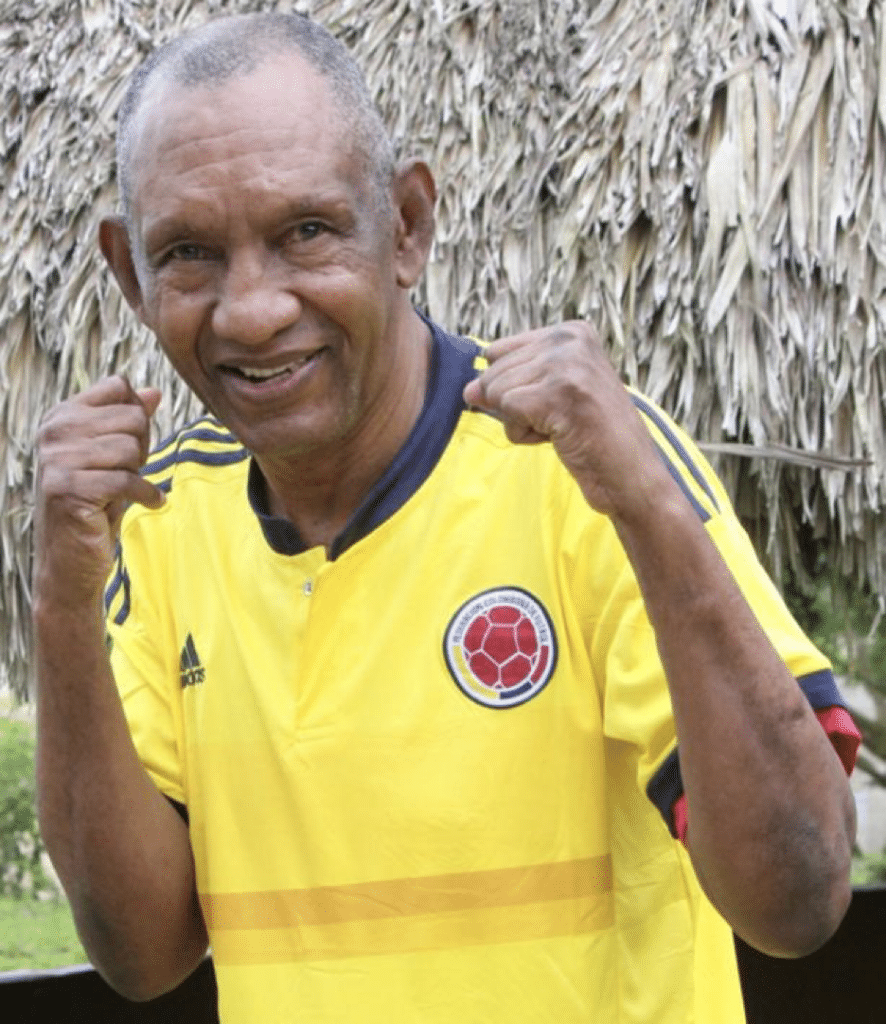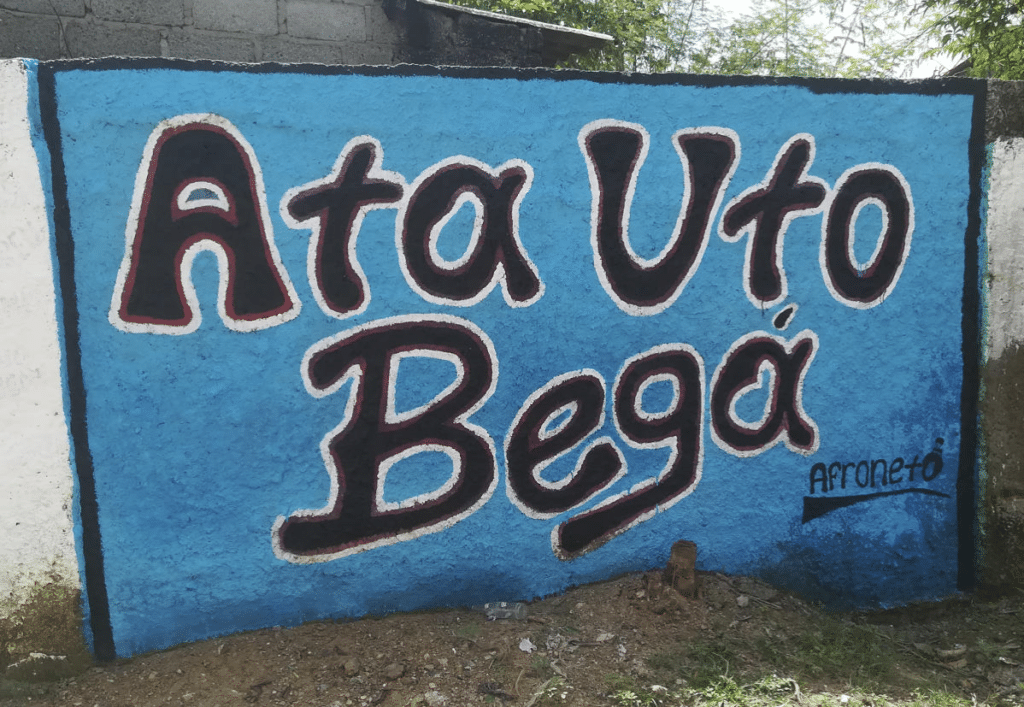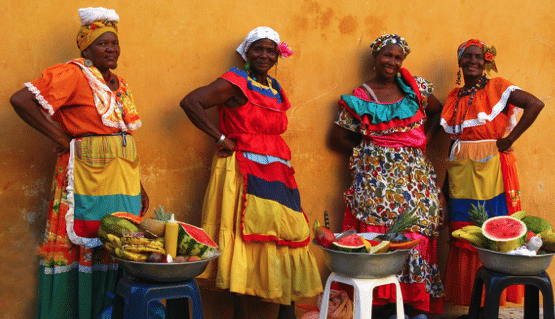For a delightful hour that seemed mere minutes we sat around the back terrace of Rafael Maria Cassiani Cassiani’s house in Palenque, mesmerized by the soft voice of the folkloric hero as he regaled us with the stories of his adventures over the years. Bare-chested, sporting an enormous medallion, and sitting upon and twanging his marimbula, “el maestro” spoke at length about his part in the history of the town.

Ma hende di tiela mi – (Palenque for ‘the people of my land’)
Situated deep in the foothills of the Montes de Maria mountains about two hours from Barranquilla in the municipality of Mahates, Bolivar, San Basilio de Palenque is steeped in rich history. It is the last of the original palenques (walled towns) formed by escaped African slaves during the terror reign of the sixteenth-century Spanish crown and indeed, it holds the distinction of being the first free slave town of the Americas.

Before slavery was abolished in Colombia in 1851 more than a million Africans were stolen from their homelands, shipped to the Port of Cartagena, and sold off like cattle to buyers from as far north as Costa Rica and as far south as Peru. Such is the story of Benkos Biohó, a West African king who in 1596 was dragged by a Portuguese slave trader from his homeland off the coast of what is now Guinea-Bissau. He was taken to Cartagena and sold to a Spaniard named Alonso del Campo who sent him up the Magdalena on a slave barge bound for a life of hard labour. Thankfully, the barge began to sink (for reasons unknown) and he was able to escape captivity along with several others.
Before long, Biohó corraled an army of escaped slaves who used weapons stolen from the Spanish to defend their positions in the marshes around Cartagena. Eventually, they found a strategic location to set up camp and began building the “village of the maroons“, a heavily-fortified palenque in the Montes de Maria where escaped slaves from all over could find safety. After much bloodshed with the Spanish garrisoned at Cartagena, a peace treaty was established with the local government which had grown tired of war with the maroons (a Spaniard term for the escaped slaves who had settled with indigenous peoples), and for a while there was calm.

Of course, nothing lasts, and in 1621, amid fears that Biohó had become too powerful and needed to be silenced, the Spanish governor of Cartagena broke the treaty and ordered his execution. The executioner hanged him not long after in a public square. To this day, many believe that it was that treacherous act by the powers that be that led to the current distrust of government by the Colombian populace.
It took 70 more years for the Spanish crown to finally issue a decree freeing the slaves of San Basilio de Palenque, and in 1691, the first free colony of the Americas became official. Declared a UNESCO heritage site in 2005, San Basilio de Palenque greets visitors with a riveting statue of Benkos Biohó, situated in the town’s square, chains broken, reaching out to his African homeland.

Maestro Cassiani Cassiani (1934 – 2022) is just one of a multitude of colorful characters who have added to the shine of this tiny village of about 3600 people. The most well-known are certainly the women of Palenque who you can see selling all sorts of delicious sweets throughout the Northern coastal region. Dressed in their colorful traditional gowns, many Palenque women make a daily trek to the nearby cities of Cartagena and Barranquilla, gigantic baskets of candy and fruit on their heads, hoping to sell their products to the hordes of tourists.

When you arrive in Palenque, it’s hard not to notice the dissimilarities from other towns in the area. From the dark brown pigmentation of the locals’ skin – clearly highlighting their African origin in contrast with the lighter shades typical of Latinos in Colombia, to the lilt of their voices speaking what villagers call ‘Lengua’, the only Spanish-centered Creole language in the world, drawing its origins from the Kikongo language of the Congo and Angola. Both are stark reminders of the Palenques’ tragic transference to South America.

On the other hand, like many other towns along the coast, Palenque is very poor – the lack of gainful industry in the region has taken its toll on the buildings and the population, and everywhere you look you can see older folks sitting around, passing time. In the unpaved streets, shoeless children run rampant. And yet, where most North American towns in the same situation would be quiet and barren, Palenque is a cacophony of noise. Music is king here and they take it very seriously. From the traditional melodies of Bullerenge sentado, Son de negro, and Son de palenquero, to the sensual rhythm and moves of champeta, originally native to San Basilio but now famous across Latin America, San Basilio de Palenque is alive with song, music, and dance.
Maestro Cassiani is the most well-known of all the Palenquero champeta legends alongside Charles King and Louis Towers and a close second are the fantastic sounds of Kombilesa Mi, a local band that merges champeta-inspired melodies with the modern beats of hip-hop and then lays on a rap track of Palenquero Lengua. It’s a sound native to Palenque, experienced nowhere else on the planet.

Every October, the town hosts a three-day music festival (Festival de Tambores y Expresiones Culturales) where townsfolk treat visitors to a mix of local and international musicians and dancers. It’s a must-see event! If you can’t make it in October, don’t fret – there are many musical groups in town who love performing for tourists year-round – it’s a real sight to see, and if you’re lucky, they’ll pull you right in to dance with them!

Another of the famous characters of Palenque is Antonio ‘Kid Pambelé’ Cervantes (1945- ), one of the world’s most well-regarded boxers and a two-time World Jr. Welterweight champion. In 1972 he became Colombia’s first world title winner, which he successfully defended 16 times. For a Palenquero boy who grew up selling contraband and polishing shoes on the streets of Cartagena, Cervantes has become a hero in the eyes of palenqueros, and to this day, his statue, with gloves held high, lies just off the main square next to the site of his original home.

If you do nothing else in San Basilio de Palenque, you absolutely need to stay for lunch. The Palenque women are world-famous for mixing up the most delicious elements of West African and Caribbean cuisine. Indeed, in 2014, a group of Palenqueros received an international award for having created the “World’s Best Cookbook”, a masterpiece that teaches cooking and Palanquero Lengua while detailing the finer points of each of their traditional dishes. If you want, you can download that cookbook by clicking here.
When I last went to Palenque, the townsfolk treated us to wonderful fried Red Snapper on a bed of sweet coconut rice with a rich mango sauce, all served on a natural leaf. It was as delicious as it looked; easily some of the best food I’ve had. After lunch, they offered us tasty Palenquero sweets, handmade by the local women – mixes of coconut and local fruits with panela (a delicious cane sugar), and served coffee in Totumo shells, the husk of the tutomo fruit.

You should definitely pay a visit to San Basilio de Palenque; it’s a feast for the senses and a picturesque, magical trek back into times long past. To see what all the hoopla’s about, I recommend reaching out to John at CostayCultura, a full-service bilingual tour company based out of Barranquilla that brings tourists and locals alike on treks to hotspots across the coast. I’ve used them a few times and I’ve been extremely happy with their services.

More info: This video does a good job demonstrating the day-to-day life of a Palenquero (note – it’s in Spanish)

